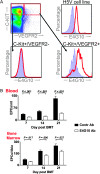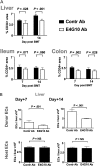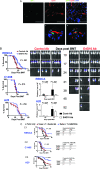Inhibition of neovascularization to simultaneously ameliorate graft-vs-host disease and decrease tumor growth
- PMID: 20463307
- PMCID: PMC2886094
- DOI: 10.1093/jnci/djq172
Inhibition of neovascularization to simultaneously ameliorate graft-vs-host disease and decrease tumor growth
Abstract
BACKGROUND Blood vessels are formed either by sprouting of resident tissue endothelial cells (angiogenesis) or by recruitment of bone marrow (BM)-derived circulating endothelial progenitor cells (EPCs, vasculogenesis). Neovascularization has been implicated in tumor growth and inflammation, but its roles in graft-vs-host disease (GVHD) and in tumors after allogeneic BM transplantation (allo-BMT) were not known. METHODS We analyzed neovascularization, the contribution of endothelial cells and EPCs, and the ability of anti-vascular endothelial-cadherin antibody, E4G10, to inhibit neovascularization in mice with GVHD after allo-BMT using immunofluorescence microscopy and flow cytometry. We examined survival and clinical and histopathologic GVHD in mice (n = 10-25 per group) in which GVHD was treated with the E4G10 antibody using immunohistochemistry, flow cytometry, and cytokine immunoassay. We also assessed survival, the contribution of green fluorescent protein-marked EPCs to the tumor vasculature, and the ability of E4G10 to inhibit tumor growth in tumor-bearing mice (n = 20-33 per group) after allo-BMT using histopathology and bioluminescence imaging. All statistical tests were two-sided. RESULTS We found increased neovascularization mediated by vasculogenesis, as opposed to angiogenesis, in GVHD target tissues, such as liver and intestines. Administration of E4G10 inhibited neovascularization by donor BM-derived cells without affecting host vascularization, inhibited both GVHD and tumor growth, and increased survival (at 60 days post-BMT and tumor challenge with A20 lymphoma, the probability of survival was 0.29 for control antibody-treated allo-BMT recipients vs 0.7 for E4G10-treated allo-BMT recipients, 95% confidence interval = 0.180 to 0.640, P < .001). CONCLUSIONS Therapeutic targeting of neovascularization in allo-BMT recipients is a novel strategy to simultaneously ameliorate GVHD and inhibit posttransplant tumor growth, providing a new approach to improve the overall outcome of allogeneic hematopoietic stem cell transplantation.
Figures






Similar articles
-
Selective targeting of angiogenic tumor vasculature by vascular endothelial-cadherin antibody inhibits tumor growth without affecting vascular permeability.Cancer Res. 2002 May 1;62(9):2567-75. Cancer Res. 2002. PMID: 11980651
-
[Effects of immature dendritic cells genetically modified to express sTNFR I on graft-versus-host disease (GVHD) and graft-versus-leukemia (GVL) in allogeneic bone marrow transplantation mice].Zhonghua Xue Ye Xue Za Zhi. 2012 Feb;33(2):88-93. Zhonghua Xue Ye Xue Za Zhi. 2012. PMID: 22730654 Chinese.
-
[Influence of donor T(reg) cells on GVHD and hematopoietic reconstitution after allogeneic bone marrow transplantation in mice].Zhongguo Shi Yan Xue Ye Xue Za Zhi. 2007 Jun;15(3):547-52. Zhongguo Shi Yan Xue Ye Xue Za Zhi. 2007. PMID: 17605863 Chinese.
-
[PBSCT and GVHD].Rinsho Byori. 1999 May;Suppl 110:92-8. Rinsho Byori. 1999. PMID: 10475037 Review. Japanese.
-
Role of hematopoietic lineage cells as accessory components in blood vessel formation.Cancer Sci. 2006 Jul;97(7):568-74. doi: 10.1111/j.1349-7006.2006.00223.x. Cancer Sci. 2006. PMID: 16827795 Free PMC article. Review.
Cited by
-
Endothelial damage and dysfunction in acute graft-versus-host disease.Haematologica. 2021 Aug 1;106(8):2147-2160. doi: 10.3324/haematol.2020.253716. Haematologica. 2021. PMID: 32675225 Free PMC article.
-
Treatment with a rho kinase inhibitor improves survival from graft-versus-host disease in mice after MHC-haploidentical hematopoietic cell transplantation.Biol Blood Marrow Transplant. 2014 Aug;20(8):1104-11. doi: 10.1016/j.bbmt.2014.04.029. Epub 2014 May 2. Biol Blood Marrow Transplant. 2014. PMID: 24796280 Free PMC article.
-
Ocular Graft-versus-Host Disease in a Chemotherapy-Based Minor-Mismatch Mouse Model Features Corneal (Lymph-) Angiogenesis.Int J Mol Sci. 2021 Jun 8;22(12):6191. doi: 10.3390/ijms22126191. Int J Mol Sci. 2021. PMID: 34201218 Free PMC article.
-
Remodeling the Vascular Microenvironment of Glioblastoma with α-Particles.J Nucl Med. 2016 Nov;57(11):1771-1777. doi: 10.2967/jnumed.116.173559. Epub 2016 Jun 3. J Nucl Med. 2016. PMID: 27261519 Free PMC article.
-
EASIX predicts non-relapse mortality after haploidentical transplantation with post-transplant cyclophosphamide.Bone Marrow Transplant. 2023 Mar;58(3):247-256. doi: 10.1038/s41409-022-01874-5. Epub 2022 Nov 21. Bone Marrow Transplant. 2023. PMID: 36414698
References
-
- Ferrara N, Kerbel RS. Angiogenesis as a therapeutic target. Nature. 2005;438(7070):967–974. - PubMed
-
- Jain RK. Normalization of tumor vasculature: an emerging concept in antiangiogenic therapy. Science. 2005;307(5706):58–62. - PubMed
-
- Ellis LM, Hicklin DJ. VEGF-targeted therapy: mechanisms of anti-tumour activity. Nat Rev Cancer. 2008;8(8):579–591. - PubMed
Publication types
MeSH terms
Substances
Grants and funding
LinkOut - more resources
Full Text Sources
Other Literature Sources
Medical

